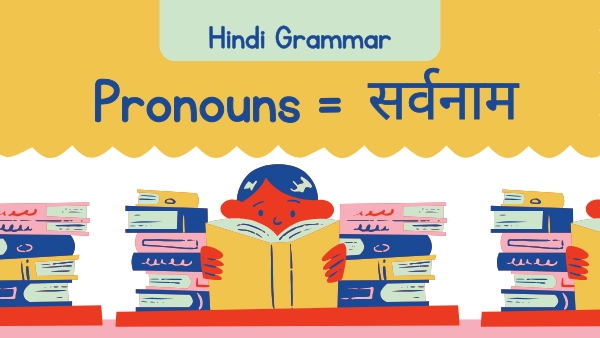In English language, it took centuries to think about gender-neutral pronouns. It's 2022 and most of us are still struggling to use English pronouns without discriminating against any genders.
But, guess what? Most Hindi speakers have been using gender-neutral pronouns since a long time. As Hindi learners, you must be proud that Hindi has gender-neutral pronouns unlike many languages.
Having said that, as nice as gender-neutral pronouns sound, they're also equally confusing and hard while learning.
Especially, non-native speakers often think Hindi pronouns as one of the major reasons why Hindi is so hard to learn. If you've ever tried learning Hindi, you may have already learned some pronouns. But why not go down the rabbit hole with me and figure out what it is all about?
- What is Pronoun?
- Conclusion
- FAQs
- 1. What are pronouns in Hindi?
- 2. What are the different types of pronouns in Hindi?
- 3. How do pronouns change based on gender and number in Hindi?
- 4. Can you provide examples of sentences using different types of pronouns?
- 5. What are some exercises for practicing pronouns in Hindi?
- 6. Where can I find more resources to study Hindi pronouns?

What is Pronoun?

सर्वनाम क्या होते है ? The word सर्वनाम ( Sarva-naam) is made up of two words. सर्व ( Sarva ), which means everyone, and नाम ( Naam ), which means name.
Bring these two words together, and you get सर्वनाम ( Sarva-Naam ) which means "name of all." Like English, pronouns (सर्वनाम) are words that are used in place of a noun (संज्ञा).

संज्ञा के स्थआन पर जिन शब्दों के उप्योग होता है उन्हे सर्वनाम कहा जाता है | Pronouns are used in a sentence if the same noun repeats itself. They are used to maintain the language's legibility, readability, and clarity.
Pronouns play a significant role in simple sentence structure as well. To learn about Hindi nouns before diving into pronouns, go there.

1. The 6 Types of Pronouns in Hind
The versatility of styles in Hindi made it necessary to divide pronouns into six types or categories.
व्यक्तिवाचक सर्वनाम ( Personal pronouns )
निश्चयवाचक सर्वनाम ( Definite pronouns )
अनिश्चयवाचक सर्वनाम ( Indefinite pronouns )
सम्बंधवाचक सर्वनाम ( Relative pronouns )
प्रश्नवाचक सर्वनाम ( Interrogative pronouns )
निजावाचक सर्वनाम ( Reflexive pronouns ) Let's learn about each one of them, shall we?
Let's learn about each one of them, shall we?
व्यक्तिवाचक सर्वनाम
(Vyakti-vaachak sarva-naam) (Hindi Personal pronouns) The first type that we are going to discuss is व्यक्तिवाचक सर्वनाम, the personal pronouns.
These are pronouns that the speaker uses for himself or the listener (whom he is talking to) or for the person he / she is talking about. व्यक्ति (Vyakti) means 'masculine,' but in this context, it refers to 'person' and not gender identity. It is further divided into 3 subcategories
उत्तम व्यक्तिवाचक सर्वनाम ( UttamVyakti-vaachak Sarva-Naam ) ( Perfect personal pronoun) The speaker uses these pronouns for himself Example: मै (mein) , मेरा (mera) ,
The speaker uses these pronouns for himself Example: मै (mein) , मेरा (mera) , हम (Hum) , हमारा (humara) i.e. I, Mine, We, Our. This can be considered equivalent to the first-person point of view that exists in English.
मध्यम व्यक्तिवाचक सर्वनाम ( madhyam Vyakti-vaachak Sarva-Naam) ( Middle personal pronoun) The speaker uses these pronouns for the listener. Example: तुम ( tum ) ,तू (Tu ),आप (Aap) i.e You This can be considered equivalent to the second-person point of view that exists in English.
The speaker uses these pronouns for the listener. Example: तुम ( tum ) ,तू (Tu ),आप (Aap) i.e You This can be considered equivalent to the second-person point of view that exists in English.
अन्य व्यक्तिवाचक सर्वनाम( anya Vyakti-vaachak sarva-naam ) ( Other Pronoun ) The speaker uses these pronouns to talk about the 3rd person. Example: वह( vaha ), वे (veh), उसे ( usey), i.e., He, She, Him/Her. This can be considered equivalent to the third-person point of view that exists in English. More Examples:
The speaker uses these pronouns to talk about the 3rd person. Example: वह( vaha ), वे (veh), उसे ( usey), i.e., He, She, Him/Her. This can be considered equivalent to the third-person point of view that exists in English. More Examples:
व्यक्तिवाचक सर्वनाम (Personal pronouns) Singular pronoun | ||
Hindi | English | |
उत्तम व्यक्तिवाचक सर्वनाम ( uttam vyakti vaachak sarva-naam ) ( 1st person view ) | मैं ( mein ) | I |
मध्यम व्यक्तिवाचक सर्वनाम ( madhyam vyakti vaachak sarva-naam ) ( 2nd person view ) | आप (aap) | You |
तुम (Tum) | You | |
अन्य व्यक्तिवाचक सर्वनाम ( anya vyakti vaachak sarva-naam ) ( 3rd person view ) | यह (yaha) | It |
वह (vaha) | He | |
वे (veh) | She |
व्यक्तिवाचक सर्वनाम(Personal pronouns) Plural pronoun | ||
Hindi | English | |
उत्तम व्यक्तिवाचक सर्वनाम ( uttam vyakti vaachak sarva-naam ) ( 1st person view ) | हम (ham) Or हम लोग (ham Log) Or हम सब (ham Sab) | We |
मध्यम व्यक्तिवाचक सर्वनाम ( madhyam vyakti vaachak sarva-naam ) ( 2nd person view ) | आप सब (aap Sab) | You |
तुम सब (Tum Sab) | You | |
अन्य व्यक्तिवाचक सर्वनाम ( anya vyakti vaachak sarva-naam ) ( 3rd person view ) | वे (veh) | They |
निश्चयवाचक सर्वनाम
(nishchay vaachak Sarva-Naam) (Definite pronouns/ Demonstrative pronouns) These pronouns refer to a definite object; they are categorized as निश्चयवाचक सर्वनाम.
Example: यह मेरी किताब है | - Which means: This is my book. Here यह is the निश्चयवाचक सर्वनाम. More example:
निश्चयवाचक सर्वनाम ( Definite pronouns ) | |
Hindi | English |
वही | The same |
ऐसा / ऐसी (aiSaa / aiSii) | Such |
यह (yeh) | This |
ये (ye) | These |
वहाँ (vahaan) | There |
वे (ve) | Those |
यहाँ (yahaan) | Here |
अनिश्चयवाचक सर्वनाम
(anishchay vaachak sarva-naam) (Indefinite pronouns) The pronoun which does not refer to something specific or definitive is called अनिश्चयवाचक सर्वनाम ( Indefinite pronouns).
Example: बाहर कोई है | which means - There's someone outside. Here कोई is the अनिश्चयवाचक सर्वनाम. More Example:
अनिश्चयवाचक सर्वनाम ( Indefinite pronouns ) | |
Hindi | English |
कुछ भी (kuch bhii) | Anything |
जो कोई भी (jo koii bhii) | Whoever |
कोई भी (koii bhii) | Anyone |
कहीं नहीं (kahiin Nahiin) | Nowhere |
सब कुछ (Sab kuch) | Everything |
कहीं (kahiin) | Somewhere |
किसी को (kiSii ko) | Someone |
सब जगह (Sab jagah) | Everywhere |
सम्बंधवाचक सर्वनाम
(sambandh vaachak sarva-naam) (Relative pronouns) Pronouns that are used to connect two different pronouns in a conversation are called सम्बंधवाचक सर्वनाम ( Relative pronouns ).
Example: जैसे (like this), वैसे ( like that ).
More examples
सम्बंधवाचक सर्वनाम ( Relative pronouns ) | |
Hindi | English |
जब (jab) | When |
जहाँ (jahaan) | Where |
जिसने (jiSaNe) | Who |
जो (jo) | Which |
जो (jo) | That |
प्रश्नवाचक सर्वनाम
(prashna vaachak sarva-naam) (Interrogative pronouns) The pronouns which give a sense of question about any person, animal or action, etc. is called प्रश्नवाचक सर्वनाम ( Interrogative pronouns )
Example: कौन (who), किसे (whom), क्या ( what )
More Example
प्रश्नवाचक सर्वनाम ( Interrogative pronouns ) | |
Hindi | English |
कब (kab) | When |
क्या (kyaa) | What |
कहाँ (kahaan) / किधर (kiDHar) | Where |
क्यों (kyon) | Why |
किसका (kiSkaa) / किसकी (kiSkii) | Whose |
कौन सा (kauN Saa) / सी (Sii) | Which |
किसे (kiSe) / किसको (kiSako) | Whom |
कौन (kauN) | Who |
निजावाचक सर्वनाम
(nijaa vaachak sarva-naam) (Reflexive pronouns) The pronouns which are used to depict themselves are called निजावाचक सर्वनाम ( Reflexive pronouns ).
Example: स्वयम (Swayam ) , खुद ( Knud ) , आप ( Aap ).
More Example
निजावाचक सर्वनाम ( Reflexive pronouns ) | |
Hindi | English |
स्वयम (Swayam ) , or खुद ( Knud ) , or आप ( Aap ). | Myself |
Himself | |
Herself | |
Yourself | |
Themselves | |
Ourselves |
2. Why are Pronouns Important in Hindi?
The primary function of having these many pronouns in Hindi is to make communication and writing clean. They improve the flow and make things effortless, vibrant, and unique.
Unlike English grammar, all pronoun words in Hindi play a prominent role in enhancing the eloquence of the language. Which makes it essential to use the pronouns, keeping verb agreement in your mind.
Practice Exercises For Hindi Pronouns
Fill in the correct pronoun
------ हिन्दी मे लिख सक्ता है |
------ अभी स्कूल जायेंगे |
दरवाजा खोलो, ----- आया है |
----- मेरी घडी है |
----- हिमाचल गये थे |
------ यदि इतना आग्रह कर रहे हो तो मै गाना सुना देता हूँ |
Use the below pronouns in a sentence
वह - _____________________
मेरी - _____________________
हम - _____________________
आप - _____________________
कौन - _____________________
कब - _____________________
जिसने - ___________________
जो कोई भी - _______________
वहाँ - _____________________
जो - _____________________
Underline the correct pronoun and write in the empty space
" अग्निपथ" शीर्षक कविता किसकी है ? _______________________
मैं परीक्षा लिखने जा रही हूँ | ___________________________
उसकी बहन एक बोहोत अच्छी कलाकार है | ______________________
बाहर कौन है ?! _____________________________
वह बेंगलोर में रह्ते है | ______________________________
हमें अपना काम करना है | ___________________________
यह किताब किसकी है ?____________________________
वह बोहोत अच्छी शतरंज खेल्ता है | _______________________
तुम किधर से आ रहे हो ? _____________________
जैसी कर्नी वैसी भर्नि | __________________________


Conclusion
We have discussed quite a lot in this article. We talked about the six different pronouns—each with its distinct usage. We also talked about different perspectives such as उत्तम, मध्यम & अन्य, that are used in parts of speech.
We know that learning Hindi pronoun can be tricky, especially when there is so much to understand. However, the more you immerse yourself into the language, the faster you will progress in understanding its grammar.
Remember that Hindi is a gender-inclusive language, and gender-neutral pronouns exist for this. Take up online Hindi courses, dive into literature, watch movies and listen to songs. Practice making simple sentences using correct pronouns.
There are many reasons you would love to learn Hindi. The more you surround yourself with the language, the more eloquent you will be.

FAQs
1. What are pronouns in Hindi?
Pronouns in Hindi are words that replace nouns in a sentence. They help avoid repetition and make sentences clearer and more concise.
In Hindi, pronouns can be categorized into different types, such as personal, demonstrative, interrogative, and relative pronouns.
2. What are the different types of pronouns in Hindi?
Personal Pronouns: Used to refer to a specific person or thing. Examples include:
मैं (main) - I
तुम (tum) - you (informal)
वह (vah) - he/she/it
Demonstrative Pronouns: Used to point out specific things. Examples include:
यह (yah) - this
वह (vah) - that
Interrogative Pronouns: Used to ask questions. Examples include:
कौन (kaun) - who
क्या (kya) - what
Relative Pronouns: Used to connect clauses. Example:
जो (jo) - who/that
3. How do pronouns change based on gender and number in Hindi?
In Hindi, pronouns change based on the gender (masculine or feminine) and number (singular or plural).
For instance, the first-person pronoun "मैं" (main) remains the same in gender, but the second-person plural form "आप" (aap) is formal and used for both genders.
4. Can you provide examples of sentences using different types of pronouns?
Sure! Here are some examples:
Personal Pronoun:
मैं स्कूल जा रहा हूँ। (Main school ja raha hoon.) - I am going to school.
Demonstrative Pronoun:
यह मेरा घर है। (Yah mera ghar hai.) - This is my house.
Interrogative Pronoun:
कौन वहाँ है? (Kaun vahaan hai?) - Who is there?
Relative Pronoun:
यह किताब जो तुमने दी थी, अच्छी है। (Yah kitaab jo tumne di thi, acchi hai.) - This book that you gave is good.
5. What are some exercises for practicing pronouns in Hindi?
Here are some exercises you can try:
Replace the noun in the following sentence with the appropriate pronoun:
सुरेश स्कूल जा रहा है। (Suresh school ja raha hai.)
Fill in the blanks with the correct pronoun:
_____ (तुम/आप) कहाँ जा रहे हो?
Convert the following sentence using a demonstrative pronoun:
वह एक किताब है। (Vah ek kitaab hai.)
Ask a question using an interrogative pronoun:
_____ (क्या/कौन) तुम्हारे साथ है?
6. Where can I find more resources to study Hindi pronouns?
You can explore various online platforms, Hindi grammar books, and language learning websites.
Additionally, practicing with native speakers and using language exchange apps can greatly help improve your understanding of pronouns in Hindi.


Comments